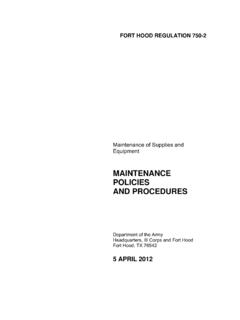Transcription of BY ORDER OF THE COMMANDER AIR FORCE MATERIEL …
1 BY ORDER OF THE COMMANDER AIR FORCE MATERIEL COMMAND. AIR FORCE MATERIEL COMMAND INSTRUCTION 21-101. 14 JUNE 2012. maintenance DEPOT maintenance . ACTIVATION PLANNING. COMPLIANCE WITH THIS PUBLICATION IS MANDATORY. ACCESSIBILITY: Publications and forms are available for downloading or ordering on the e- Publishing website at RELEASABILITY: There are no releasability restrictions on this publication OPR: HQ AFMC/A4DC Certified by: HQ AFMC/A4D. (Mr. Brian Burks). Pages: 46. Supersedes: AFMCI21-101, 18 February 1994. This instruction implements Air FORCE Policy Directive (AFPD) 21-1, Air and Space maintenance , and Air FORCE Instruction (AFI) 63-101, Acquisition and Sustainment Life Cycle Management. It further prescribes responsibilities for formulating and implementing the Depot maintenance Activation Plan (DMAP) for new systems, subsystems, equipment, munitions, and major modifications.
2 This publication describes policies, operating procedures, and assigns responsibilities for the DMAP at all Air FORCE MATERIEL Command (AFMC) Air Logistics Centers (ALCs); Product Centers; Air FORCE Metrology and Calibration (AFMETCAL); Space and Missile Systems Center; organizations within the Air FORCE Global Logistics Support Center (AFGLSC); and in-theater repair facilities. It does not apply to Air National Guard (ANG) or Air FORCE Reserve Command (AFRC) and their units. Refer recommended changes and questions about this publication to the Office of Primary Responsibility (OPR) using Air FORCE (AF) Form 847, Recommendation for Change of Publication. Ensure that all records created as a result of processes prescribed in this publication are maintained in accordance with Air FORCE Manual (AFMAN) 33-363, Management of Records, and disposed of in accordance with the Air FORCE Records Information Management System (AFRIMS) Records Disposition Schedule (RDS) located at See Attachment 1.
3 For a glossary of references and supporting information. 2 AFMCI21-101 14 JUNE 2012. SUMMARY OF CHANGES. This document is substantially revised and must be completely reviewed. It reflects new office symbols throughout the instruction; incorporates major changes to the depot maintenance activation planning process; and provides updated guidance, terms, and references. This publication requires the collection and or maintenance of information protected by the Privacy Act of 1974 authorized by (legal authority such as federal statute, executive ORDER , etc). The applicable Privacy Act SORN(s) (number and title) is available at chapter 1 introduction 4. Overview.. 4. DMAWG Initiation.. 5. Figure Depot maintenance Activation Working Group (DMAWG) Structure.
4 6. Figure Depot maintenance Activation Flow .. 7. Figure Proposed Depot Activation in the Acquisition Cycle .. 8. Roles and Responsibilities.. 8. chapter 2 DEPOT maintenance ACTIVATION PLANNING AND CONTRACT. STRATEGY 15. Development.. 15. Formal Planning.. 15. Modifications to DMAP.. 15. chapter 3 ACTIVITIES OVERVIEW 16. Activities pre-MS A ( MATERIEL Solution Analysis Phase).. 16. Activities pre-MS B (Technology Development Phase).. 16. Activities pre-MS C (Engineering and Manufacturing Development Phase) .. 17. Activities post-MS C (Production & Deployment Phase) and for Legacy Systems.. 19. Activities during Operations and Support (O&S) for Legacy Systems.. 20. chapter 4 DEPOT ACTIVATION FOR SPECIAL CIRCUMSTANCES 22.
5 Special Circumstances.. 22. Attachment 1 GLOSSARY OF REFERENCES AND SUPPORTING INFORMATION 23. Attachment 2 SAMPLE DEPOT maintenance ACTIVATION WORKING GROUP. (DMAWG) CHARTER 29. Attachment 3 SAMPLE DEPOT ACTIVATION CHECKLIST 34. AFMCI21-101 14 JUNE 2012 3. Attachment 4 SAMPLE DEPOT maintenance ACTIVATION PLAN 38. Attachment 5 SAMPLE DEPOT-LEVEL REPAIR (DLR) INTEGRATED MASTER. SCHEDULE (IMS) 44. Attachment 6 DEPOT ORGANIC CAPABILITY LETTER 46. 4 AFMCI21-101 14 JUNE 2012. chapter 1. introduction . Overview. Depot maintenance activation planning requirements are defined through systems engineering process and, in particular, through the life cycle sustainment planning process. The following paragraphs are an overview of the main elements of planning requirements.
6 It is Department of Defense (DoD) policy (DoD Directive , maintenance of Military MATERIEL ) to provide organic maintenance for inherently Governmental and core capability requirements in accordance with Title 10 United States Code (USC) 2464, Core Logistics Capabilities. This publication provides guidance in depot activation and establishing the organic capability at the ALCs. Sustainment planning begins early in the acquisition process, pre-Milestone (MS) A. It can also begin any time major changes occur due to: (1) a 20 percent or more increase in labor hours, cost or quantities; (2) major deficiencies or safety mishaps; (3) modifications;. (4) Material Improvement Projects; (5) approval of major cost savings efforts from accepted suggestions; (6) other major changes not described here.
7 Any of these major changes may generate a new Depot Source of Repair (DSOR) decision. HQ AFMC/A8/9 manages the AFMC Mission Assignment (MA) process, which assigns acquisition and sustainment management responsibilities for weapon systems and programs to the appropriate Center. DSOR. All Air FORCE depot level maintenance posturing decisions are made through the DSOR process (reference AFI 63-101, Acquisition and Sustainment Life Cycle Management) (hardware and software). AFI 63-101 defines how a product support strategy integrates acquisition and sustainment throughout the weapon system s life cycle, and requires the Program Manager (PM) to consider core and partnered workloads in their DSOR. development. Once the DSOR has been completed, Depot maintenance Activation Working Group (DMAWG) activities begin in earnest.
8 Unless otherwise specified, for the purpose of this document the term PM will be considered synonymous with System Program Manager (SPM) or Product Group Manager (PGM), as applicable to a program. Furthermore, the PM may assign specific responsibilities to the Product Support Manager (PSM). Normally, the PSM will be the individual tasked with the majority of depot maintenance activation planning activities. The PM/PSM may also receive assistance from the Product Support Integrator (PSI). See AFI 63-101 for a description of specific duties. Funding. Funding for depot activation includes requirements for facilities, equipment, training, data, TDY, and other directly related expenses to ensure the required sustainment capability is developed.
9 The PM is responsible for including all depot activation costs in the program life cycle cost estimates that are provided to the MAJCOM for funding before MS. B, or MS C if there is no MS B. Refer to DoD Financial Management Regulation R for further guidance. AFMCI21-101 14 JUNE 2012 5. DMAWG Initiation. The DMAWG is formally initiated after DSOR completion and shall continue until all required workloads are activated. DMAWG meetings, which should occur at least quarterly, can take place virtually if warranted to conserve funds or interim virtual meetings may be needed to meet more frequent needs. Specific members may also be chosen to attend virtually if a particular meeting does not warrant their physical presence. The DSOR team will provide a foundation of information for the DMAWGs.
10 If the organic DSOR is another Service, the selected depot will provide the same support to the PO for sustainment planning and implementation. The PM or PSM (civilian or military personnel) will chair or co-chair the DMAWG with the PSI and oversee the maintenance Activation Planning Team(s) (MAPT). The selected depot will provide support to the DMAWG and MAPTs, as required, to ensure the timely stand up of capability (hardware and software). The Acquisition Sustainment (AS) Tool Kit is a source of information for depot maintenance planning (reference AFI 63-101). The AS. Tool Kit lays out DMAP tasks by phase and can provide assistance with DMAWG initiation. The DMAWG will have, as a minimum, the following voting members: The PM or PSM as chair or co-chair with the PSI; MAPT lead assigned by each selected depot that has an assigned workload; AFGLSC representative; and the owning Major Command.













